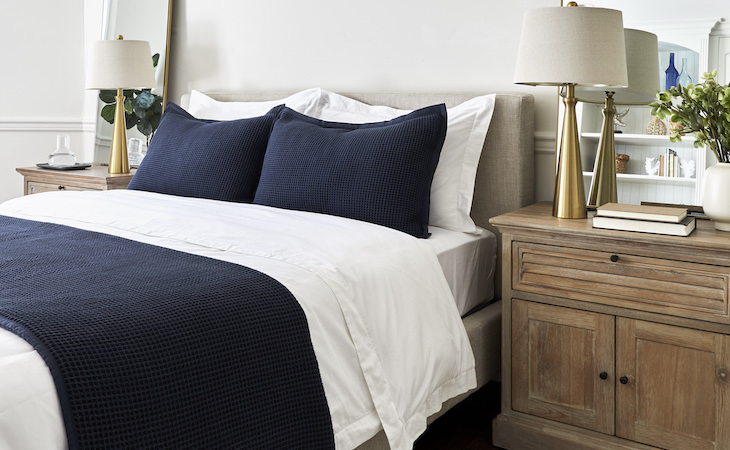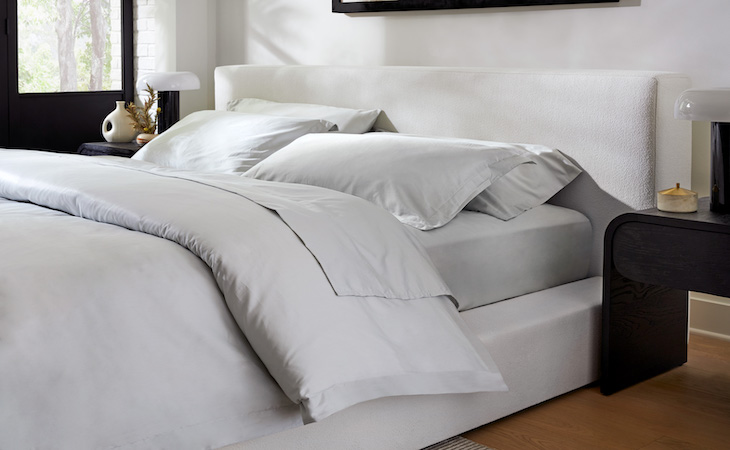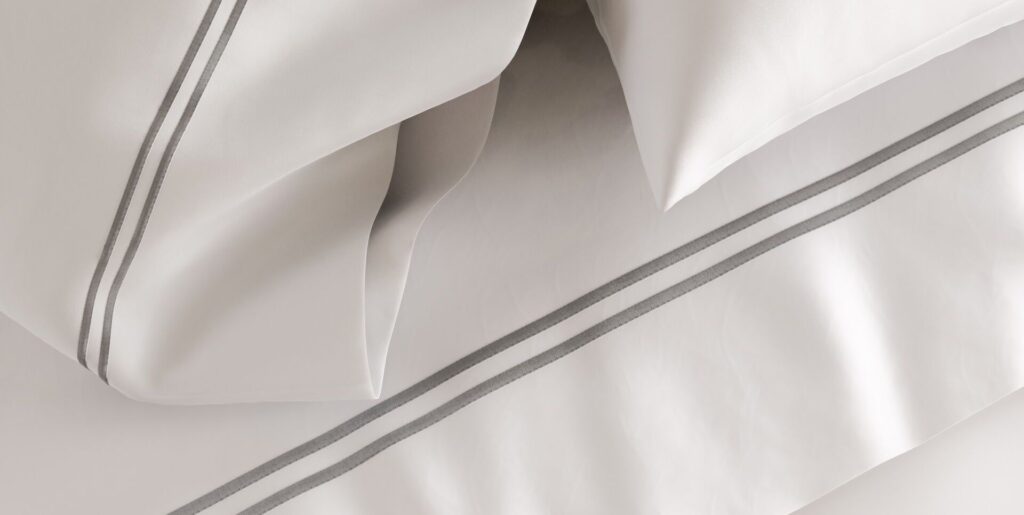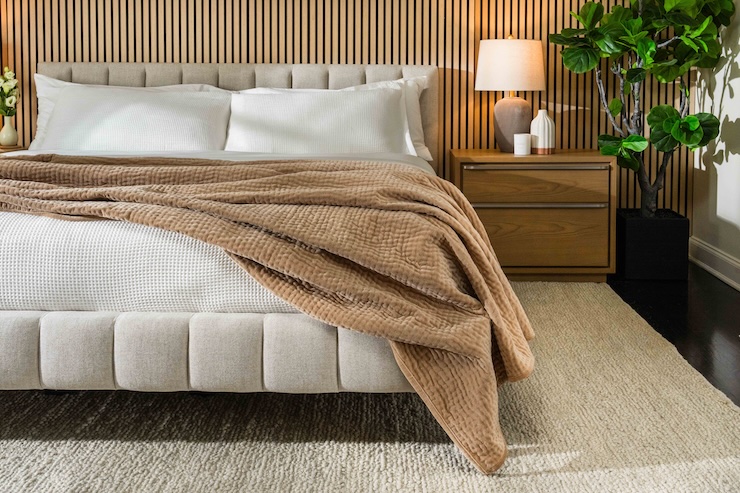
Lyocell and cotton are both breathable, durable bedding fabrics with unique strengths. Lyocell is silky, moisture-wicking, eco-friendly, and ideal for hot sleepers but requires delicate care and costs more. Cotton is versatile, affordable, low-maintenance, and long-lasting, with options like percale and sateen. The best choice depends on personal needs.
Lyocell and cotton are two excellent options for bedding. Both are comfortable, breathable, and long-lasting. The question is: which one best suits your needs?
Lyocell is a slightly silky, absorbent fabric, while cotton is one of the most popular and durable options out there.
This article covers the basics of each fabric so you can make the right choice for you.
What is lyocell?
“Lyocell is a silky soft, breathable, moisture-wicking and even resistant to wrinkles,” explains Isfira Jensen, interior designer. “It’s a fantastic option for those looking for sustainably-sourced bedding pieces.”
This semi-synthetic fabric is made from cellulose fibers that come from wood pulp, usually from eucalyptus, beech, or bamboo trees.
The pulp is dissolved in a recyclable solvent and spun into continuous fibers that are then woven into yarn. The result combines the breathability of natural fibers and the durability of synthetics.
This gives lyocell a very slight silky texture—smoother than cotton though not as slick as silk. It’s also considered a more environmentally conscious fabric thanks to the recyclable solvent used in the production process.
What is cotton?
Cotton is one of the oldest and most widely used textile fibers in the world. The fabric is soft, breathable, durable, and easy to care for. There are also many different kinds of cotton bedding, including percale and sateen.
Here’s how cotton is made: The production process begins with harvesting fluffy cotton fibers from the cotton plant, followed by ginning to separate fibers from seeds.
The fibers are cleaned, carded, spun into yarn and then woven into fabric. You might come across varieties like Pima cotton (longer fibers for softness), Egyptian cotton (extra-long staple fibers), and organic cotton (grown without synthetic pesticides).
Benefits of lyocell
- Moisture-wicking: Absorbs up to 50% more moisture than cotton, making it ideal for hot sleepers.
- Naturally antimicrobial: Resists bacterial growth, keeping your sheets fresher longer.
- Exceptionally soft and silky texture: Lyocell fabric feels smooth, comparable to high-end silk, without being too slick.
- Temperature regulation: Breathable nature maintains a comfortable sleep temperature.
- Wrinkle resistance: Lyocell typically can maintain a smoother appearance and requires less ironing.
- Environmentally conscious production: Made from renewable sources with closed-loop manufacturing.
Drawbacks of lycoell
- Higher cost: More expensive than basic cotton due to specialized manufacturing.
- Limited availability: Fewer brands and style options than cotton.
- Specific care requirements: This more delicate fabric requires gentler washing, preferably washed separately to maintain its quality.
Benefits of cotton
- Durability: With proper care, cotton is long-lasting and often gets softer over time.
- Wide variety: There are plenty of weave options, thread counts, and price points to suit any preference.
- Low-maintenance care: Most cotton sheets are easy to wash, dry, and care for.
- Breathable: Natural fibers promote airflow, especially in lightweight weaves like percale.
- Affordable options: You can find cotton sheets at budget-friendly prices.
Drawbacks of cotton
- Prone to wrinkling: You might need to iron cotton more often for a smooth appearance. “Cotton can wrinkle quite easily and will wear out quickly if it is of low quality,” shares Jensen.
- Moisture retention: Less effective at wicking moisture compared to fabrics like lyocell.
- Inconsistent quality: With so many options on the market, quality varies.
Lyocell sheets vs. cotton sheets: What’s the difference?
Durability
As one of the oldest fabrics, cotton sheets have a reputation for lasting years or even decades with proper care, and they often get softer over time.
Lyocell is equally durable, but since it’s more delicate, it requires more sensitive care to maintain its quality and avoid pilling.
Feel
Lyocell has a silky texture, without being too sheer or slippery like silk. Cotton’s feel varies: percale is crisp and breathable, while sateen is smoother and more lustrous.
Over time, cotton softens with each wash. “Higher quality options, woven with percale or sateen, affect this fabric’s feel and appearance, making it a more luxurious experience,” says Jensen.
Temperature
“Temperature regulation is where both of these fabrics shine,” notes Jensen. “These highly breathable fabrics are excellent at diverting heat away from the body.”
Lyocell specifically, though, wicks away moisture while cotton doesn’t, making it a clear winner for those looking for a great summer night bed sheet, she says.
Cotton’s breathability depends on the weave. Percale sleeps cooler, while sateen tends to retain heat.
Maintenance
Cotton is low-maintenance and can handle regular machine washing and drying. Lyocell requires gentler care (cooler water and low-heat or air drying) to maintain its softness and structure.
“The biggest complaint we get about lyocell is that exposing it to any form of heat is not advisable,” says Jensen. “To prevent fabric shrinkage and wear, it must be washed in cold temperatures and have little exposure to a dryer and ironing.”
Busy families often find the maintenance for lyocell too much for bedding, adds Jensen.
Sustainability
Lyocell is made from renewable wood sources using a manufacturing process that recycles nearly all water and solvents.
Traditional cotton has a higher environmental footprint than lyocell, though organic cotton offers a more sustainable option.
Cost
Cotton comes in a wide range of price points, while lyocell typically costs more since it’s a more specialized fabric.
“Lyocell is usually a more expensive option and isn’t as widely available as standard fabric options,” says Jensen.
The bottom line on lyocell vs. cotton sheets
Choosing between lyocell and cotton will depend on your personal preferences and sleep style.
Lyocell offers a silky texture and moisture-wicking abilities and excellent temperature regulation, which makes it a great choice for hot sleepers or those looking for a silky texture for fabric.
Cotton is a more tried and true material, offering durability, easy care, and a wide range of styles and price points.
FAQs
What are the disadvantages of lyocell?
Lyocell is generally more expensive than cotton and requires gentle care (cool washes and low-heat drying) to maintain its softness and structure.
“Due to its delicate nature, lyocell is more prone to damage during washing,” says Jensen. “It’s important to handle this garment with care and avoid high heat and overexposure to harsh chemicals.”
Is lyocell as good as cotton?
Lyocell and cotton both have strengths. Lyocell offers better moisture-wicking and a silky feel, while cotton is more affordable, widely available, and easier to care for. The best choice depends on your priorities.
Which is cooler: cotton or lyocell?
Lyocell tends to sleep cooler because of its moisture-wicking and breathability. Cotton can also be cool, especially in percale weaves, but generally retains more moisture.
Is lyocell good for summer?
Yes, lyocell is an excellent choice for summer. Its breathable, moisture-wicking properties help keep you dry and cool in warm temperatures.
Find the best sheets for you at Saatva
No matter your sleep style, Saatva has a sheet set that will be the right fit.
We have a wide range of cotton sheet sets, including organic sateen and percale, so you can choose based on your preferences and needs.
All of our sheets are made from the highest quality materials and are soft and breathable for a comfortable night’s sleep.
Leeron Hoory
Leeron is a New York City-based writer who has written for Quartz, The Observer, Slate, Salon, The Village Voice, Gothamist, and others. Read more of her work on her website.







